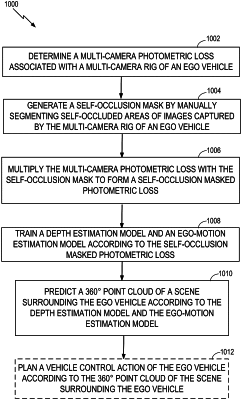| CPC G06T 7/55 (2017.01) [B60R 1/00 (2013.01); B60W 60/001 (2020.02); G05D 1/0212 (2013.01); G05D 1/0246 (2013.01); G06F 18/214 (2023.01); G06F 18/2148 (2023.01); G06N 3/08 (2013.01); G06T 3/0012 (2013.01); G06T 3/0093 (2013.01); G06T 3/40 (2013.01); G06T 7/11 (2017.01); G06T 7/292 (2017.01); G06T 7/579 (2017.01); H04N 23/90 (2023.01); B60R 2300/102 (2013.01); B60W 2420/42 (2013.01); G05D 2201/0213 (2013.01); G06T 2207/10028 (2013.01); G06T 2207/20081 (2013.01); G06T 2207/20084 (2013.01); G06T 2207/30244 (2013.01); G06T 2207/30252 (2013.01)] | 18 Claims |

|
1. A method for self-supervised depth and ego-motion estimation, the method comprising:
determining a multi-camera photometric loss associated with a multi-camera rig of an ego vehicle;
generating a self-occlusion mask by manually segmenting self-occluded areas of images captured by the multi-camera rig of the ego vehicle;
multiplying the multi-camera photometric loss with the self-occlusion mask to form a self-occlusion masked photometric loss;
training a depth estimation model and an ego-motion estimation model according to the self-occlusion masked photometric loss by leveraging cross-camera temporal contexts via spatio-temporal photometric constraints to increase an amount of overlap between cameras of the multi-camera rig using a predicted ego-motion of the ego vehicle; and
predicting a 360° point cloud of a scene surrounding the ego vehicle according to the depth estimation model and the ego-motion estimation model.
|